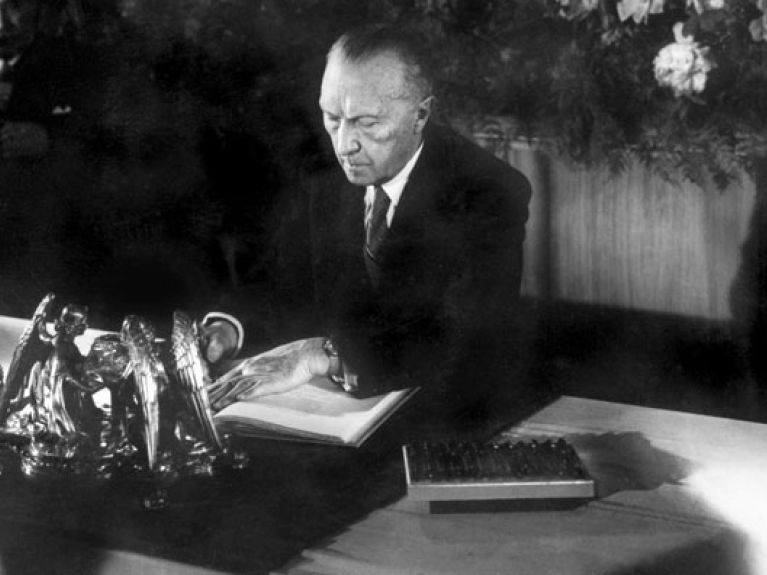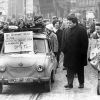30 German years: 1950 – 1980

The 1950s
End and new beginning: Nazi Germany surrenders unconditionally in May 1945. Twelve years of Nazi dictatorship have plunged Europe into the abyss, led to racial fanaticism and horrific crimes, and cost the lives of almost 60 million people in the war and the extermination camps. The victorious Allies divide Germany into four zones. The western powers foster the development of a parliamentary democracy, while the Soviet Union opens the door for socialism in the east. The Cold War begins. The Federal Republic of Germany is founded in the west with the promulgation of the Basic Law on 23 May 1949. The first Bundestag elections are held on 14 August and Konrad Adenauer (CDU) becomes Federal Chancellor. The German Democratic Republic (GDR) is founded in the “eastern zone” on 7 October 1949. Germany is in effect divided into east and west.
The young Federal Republic builds close links with the western democracies. It is one of the founding members of the European Coal and Steel Community in 1951 and one of the six countries that sign the Treaty establishing the European Economic Community – today’s European Union – in Rome in 1957. In 1955, the Federal Republic joins NATO, the western defence alliance. Economic and social stabilization makes rapid progress. In combination with the currency reform of 1948 and the US Marshall Plan, the social market economy leads to an economic upturn that is soon described as an “economic miracle”. At the same time, the Federal Republic acknowledges its responsibility towards the victims of the Holocaust: Federal Chancellor Adenauer and Israel’s Foreign Minister Moshe Sharett sign a reparations agreement in 1952. Social highlights: victory at the 1954 World Cup and the return of the last German prisoners of war from the Soviet Union in 1956.
The 1960s
The Cold War nears its climax: more and more refugees leave the GDR for the west. Accordingly, the “zonal border” is sealed off and on 13 August 1961 the GDR government ends free access to West Berlin. It builds a wall through the city, and the border with the Federal Republic becomes a “death strip”. During the next 28 years many people lose their lives attempting to cross it. President Kennedy affirmed America’s guarantee of the freedom of West Berlin during his famous speech in Berlin in 1963. It is certainly an eventful year. The Élysée Treaty, the Treaty of Friendship between France and Germany, is concluded in January as an act of reconciliation. The Frankfurt Auschwitz Trials begin and confront Germans with their Nazi past. In autumn, Economics Minister Ludwig Erhard (CDU), the “father of the economic miracle”, becomes Federal Chancellor, following Adenauer’s resignation.
Three years later, the Federal Republic is governed by a CDU/CSU and SPD Grand Coalition for the first time: Kurt Georg Kiesinger (CDU) is Federal Chancellor and Willy Brandt (SPD) is Vice Chancellor and Foreign Minister. The Federal Republic’s economy flourishes until the mid-1960s and more than two million additional personnel are recruited in southern Europe. Many of these “guestworkers” remain in the country and ask their families to join them.
The protest movement of students and intellectuals against “incrusted structures” and strict values make a strong mark on the second half of the decade. It brings about a lasting change in the political culture and society of western Germany. Feminism, new lifestyles, antiauthoritarian education and sexual freedom, long hair, debates, demonstrations, rebellion and new liberality – democracy in the Federal Republic experiments in many directions. The societal changes of this time still continue to have an impact today. An SPD politician becomes Federal Chancellor for the first time in October 1969: Willy Brandt leads a social-liberal government that implements numerous domestic reforms ranging from the expansion of the social welfare system to the improvement of education.
The 1970s
Willy Brandt kneels down at the monument to the victims of the Warsaw Ghetto. It is 7 December 1970 and the picture goes round the world. It becomes a symbol of Germany’s appeal for reconciliation, 25 years after the end of the Second World War. On the same day, Brandt signs the Treaty of Warsaw between the Federal Republic and Poland. It lays the foundation for a new peace architecture as one of a series of treaties with eastern Europe. Brandt wants to follow Adenauer’s successful western integration by opening up to eastern Europe: “change through rapprochement”. The first German-German summit between Brandt and Chairman of the GDR Council of Ministers Willi Stoph had already taken place in Erfurt in the GDR in March 1970. In 1971 Willy Brandt is honoured with the Nobel Peace Prize for his policy of understanding with the countries of eastern Europe. In the same year, with the Four Power Agreement, the Soviet Union in effect recognizes that West Berlin belongs to the economic, social and legal order of the Federal Republic of Germany. It enters into force with the other eastern treaties in 1972 and eases the situation in divided Berlin. In 1973, the Federal Republic and the GDR agree in the Basic Treaty that they will establish “normal neighbourly relations” with one another. Also in 1973, both German states become members of the United Nations. Following the unmasking of a GDR spy in his immediate circle, Willy Brandt resigns as Federal Chancellor in 1974. His successor is Helmut Schmidt (SPD). From 1973 the country’s economy is affected by the oil crisis.
The 1970s are a decade of external peace, but internal tension: the Red Army Faction (RAF) around Andreas Baader, Gudrun Ensslin and Ulrike Meinhof wants to destabilize the government, economy and society with attacks and kidnappings. The terror reaches its climax in 1977 – and concludes with the suicide of the leading terrorists in prison.


